Dangerous Art
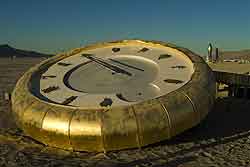
It’s that time of the year again. The time when a certain segment of the global psychedelic superculture collectively comes down with a strange form of insanity known as Burning Mania.
It’s easy to recognize the syndrome if you’ve seen it in action. For most of the year it simply expresses as a tendency to wax verbose on the topic to anyone who will pretend to listen. In the summertime, however, the condition kicks into high gear, and affected parties are thrown into a frenzy of building, buying, packing, and preparing. Then they all run off to the desert together to make art, take drugs, and generally express the fuck out of themselves.
Of course I’m talking about the Black Rock Arts Festival, otherwise known as Burning Man. Not everybody is as positive and excited about it as I am, but even its detractors cannot deny that it’s important both as a catalyst and as a consequence of the evolving psychedelic scene. Several important theme camps, such as Entheon Village, cater directly to trippers. Many modern psychedelic memoirs make mention of the festival, and I have read literally hundreds of Burning Man trip reports. The National Geographic documentary on LSD that I participated in included a segment on it, and there is even a Burning Man vault right here on Erowid.
In light of all of which (and frankly because I am now on route to Burning Man myself and therefore out of writing time), I hope that you will accept this essay in lieu of my traditional column. It’s something that Seuss dean and I wrote for a major magazine in September of 2009. It was supposed to come out around now, but the project fell through so we get to do anything we want with it. If you don’t know Burning Man, it’s the best introduction that we could come up with. If you know it and you’re missing it right now, I hope this helps with the homesickness. And if you’re actually reading this on the playa, get off of the damned computer and come play in the dust with us!
—
“Come be reborn!”
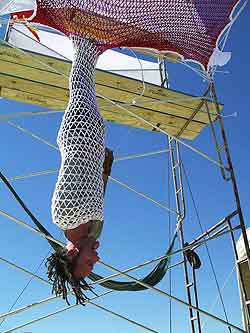
I’m standing out on the Esplanade, watching two hot chicks working the crowd. Everybody at Burning Man is hot. It must be over 100 degrees out. These girls are also adorable though, and their fluorescent faux fur bikinis don’t leave much to the imagination. I eye their installation warily. The hotties are wielding a pressurized tank of ice water, but in order to get hosed down I’d have to take off all of my clothes, climb up three stories of construction scaffolding, crawl out onto a big weblike hammock thing and wriggle face first down a long tight macramé tube. The guy who’s stuck in there now forgot to remove his piercings and one of the girls climbs up on a ladder to help him out. She asks him what he wants his new playa name to be, but he demurs. Her partner solicits suggestions from the crowd. Someone shouts out “Puppycat!”, and there is a general murmur of approval. Soon he’s twisting and screaming in the icy spray, struggling gamely to free himself while the sweaty throng chants his new moniker and cheers him on. Eventually his head emerges from the bottom of the tube, and then the rest of him, rather suddenly. He hits the ground with a thud, but he’s smiling. “Dangerous art right here in Black Rock City!” The scantily clad docent winks as she returns the nipple ring. “And you thought it was going out of style.”
Dangerous art might be on the decline at Burning Man, but to suggest that it’s passé is sort of a sacrilege. Sure there’s a ban on firearms these days, and the Molotov cocktail throwing range has long since passed from memory into legend, but the back of every ticket still says that the ticket holder “voluntarily assumes all risk of […] serious injury or death, which may occur by attending…”, and the week-long festival of community, creativity, and excess still threatens to change its participants lives forever.
Most of the time the Black Rock Desert is, well, deserted. Way back in the Pleistocene the enormous Lake Lahontan covered much of Northwestern Nevada, but relentless climate change eventually dried it all up, leaving behind a desolate playa of whitish alkali salt flats. Nothing in nature is tenacious or foolhardy enough to call the hostile environment home, and humans use it only rarely. In fact, aside from occasional attempts to break the world land speed record, nothing much goes on out there.
Once a year, however, the playa shimmers like a mirage and transforms itself almost overnight into a sort of counterculture Brigadoon. On the week leading up to Labor Day, that most forsaken of wastelands becomes Black Rock City, the seventh largest community in Nevada. It’s many things to many people, but even the most jaded of its critics agree that it’s never boring. Burning Man is a social experiment, a networking opportunity, an outdoor art museum, a rite of passage, a great excuse to blow stuff up, and the best damned party in the world. It’s a confusing co-incidence of opposites to be sure: The land itself is entirely dead and yet the event positively teems with the essence of what it means to be alive. The constraints of camping in the desert make for a stark-yet-lush, wholly human environment that is by turns austere and wildly hedonistic. Almost totally uncensored, the art itself is at once beautiful and irreverent, addressing both the sacred and the profane with the same frank and ironically self-aware panache. It is an exercise in self-reliance and also an effective demonstration of our essential interdependence. It’s an immersive experience, intended to shock the senses and stagger the mind. To compare it to any other festival would be specious. There is a truism amongst enthusiasts that Burning Man, like the psychedelic experience that informs a large subsection of its culture, cannot be satisfactorily described to a non-initiate. That doesn’t stop folks from going on and on about it about it, though, as many long-suffering friends of devoted participants can attest. First-year Burners are the worst. They sound exactly like zealous converts to some kinky new religion; except the only dogma seems to revolve around the decommodification of goods and services, radical self-expression, total participation, low environmental impact, and the primacy of immediate experience.

Ever since 1986, when founder Larry Harvey first burned a wooden effigy on Baker Beach in San Francisco, people have been asking what it all means. Larry himself has been intentionally vague on the topic. Like the homonymous event, the 70 foot tall sculpture of a man is not intended to mean anything in particular. What you take out of it depends on what you bring with you. The Burning of The Man, which occurs on Saturday night, is ritual for the sake of the ritual itself; signifying nothing and at the same time providing the framework around which to design and interpret one’s own wholly personal experience. It’s a ceremony perhaps uniquely appropriate to the largely cynical and secular citizenry of Black Rock City, many of whom would loosely define themselves as seekers after the human spirit but who are nevertheless keen to disassociate themselves from the vague fluffy newage (rhymes with sewage) that dominates the tone of many so-called “spiritual” events.
The old guard has been whining that Burning Man is dead for at least a decade. It used to be more chaotic and perhaps in a sense more free; a true temporary autonomous zone where road warrior types could toss back a few beers and bust out the old flame thrower without attracting the unwelcome attention of the local fuzz. Pot smokers didn’t have to look over their shoulders in the bad old days. You could burn your art where it stood. You could bring the dog, drive fast, and set off sketchy fireworks. You could leave a big mess behind you when you split. It was quite an experience, to be sure. You can find your camp more easily now that there are well-marked streets, though. The porta-potty situation has improved, and nobody gets run over by mutant vehicles in their sleep anymore. Still, there are those who complain that the event has been co-opted by artists (to say nothing of the masses of iPhone-packing techno-hippies and blissed-out candy ravers whom the hardcore survivalist types hold in only partially affected contempt). Yet in 2009, the art theme was Evolution, and even the crustiest of old-timers could see which way the wind was blowing when the dust was up. Nothing living stays the same. And who would want it any other way?
The environment can be pretty brutal, but that’s part of the fun. On one level it’s an ordeal ritual, intended to break participants down both physically and emotionally, leaving them more vulnerable to inspiration. The shared survival challenge is an unparalleled team-building opportunity for camp mates and strangers alike that can test friendships and strain individual sanity. It challenges human endurance on a number of levels. Triple digit temperatures are common in the daytime, and it can get downright cold at night. A homogeneous desolation of superfine salty alkali powder that erodes whatever it touches, the playa itself is almost comically pernicious. It gets into absolutely everything. It sucks the moisture from exposed skin and twists hair into fantastic playa sculptures that are almost impossible to comb out. It rarely rains, but when the wind picks up it can raise whiteouts that limit visibility to a few feet, and it’s not uncommon to see an improperly staked “tumbletent” roll by in a big playa storm. (Normal tent stakes aren’t good enough as many campers find out the hard way. The standard method for keeping things from blowing away involves rebar pounded into the playa with a sledgehammer.) Masks and goggles are de rigueur, but they only do so much good. Walking or biking for miles every day takes its toll on the body, as does the chronic dehydration and sleep disruption that can occur when a Burner gets sloppy. Catchphrases like “piss clear” and “party like a pro” remind Black Rock citizens to take good care of their physical condition. Other popular slogans address mental health issues: “Don’t sweat the petty things, just pet the sweaty things.”

Black Rock has a right to call itself a City. Peaking at around 50,000 citizens, BRC boasts everything that a major metropolis needs to function. There is a working post office (with its own postmark!) where paper mail can be sent to addresses on the playa and exchanged with the world beyond. The freaks who work there are surly and they sometimes have to be bribed, but that’s part of the art. There are theaters, schools, hospitals, and places of worship as well as entertainment establishments like bars, nightclubs, bowling alleys, and roller rinks. Extravagantly decorated art cars provide free public transportation. There is more than one daily newspaper, and several radio stations broadcast around the clock. The Department of Public Works keeps things running smoothly, as do the Black Rock Rangers, Burning Man’s own internal volunteer participant police department. Rangers work with local law enforcement to solve problems, but they’re not really cops and they’re not out to bust participants. There is surprisingly little violence and not much crime to speak of except for the possession and consumption of scheduled substances and the occasional theft. A typical call might involve a dispute between someone with ten-foot-tall speakers sitting directly on the rhythmically thumping playa and a sleepless sledgehammer-wielding neighbor who has come to his wits’ end. When words fail to achieve a satisfactory resolution, Rangers have the authority to escort malefactors to the City’s borders. Since nobody really wants to get kicked out of Burning Man, Rangers mostly get the respect and cooperation that they deserve.
It’s late Friday night, 2009, and I’m cruising for adventure. Laid out like a gigantic clock with the Man at its center, the basic map of Black Rock City has become as familiar to veteran Burners as the smell of sunscreen. I spend most of the evening wandering around in the residential zone, checking out Theme Camps. The street closest to The Man is called the Esplanade and the rest of the streets are named according to the annual art theme. The first street behind the Esplanade begins with the letter A, the second one starts with B and so forth. This year they stretched from Adapt all the way back to Lineage. That means it’s almost impossible to walk through the whole city in a week while still stopping to appreciate your most compelling finds. Even on a bike it would be a challenge. It’s like a post-apocalyptic Disneyland for adults. I know there’s no way to see it all. Even if one were to grid off the playa and go about exploring it systematically, new stuff keeps getting built all week as more and more Burners show up. The Esplanade is reserved for highly interactive Theme Camps, but far more projects fall into that category than can fit on the front row, and almost every camp in town has some sort of art set up. One of the coolest things I saw in 2009 was way the heck out at 3:30 and Jurassic.
Right now I’m heading for open playa, though. There is no camping in the half-a-mile or so between the Man and the Esplanade, and the blank canvas extends beyond the circular mandala of the City proper for quite a distance before one comes to the orange trash fence that defines the edge of the world. The open playa is reserved for art installations, and due to a persistent perceptual illusion created by the flat featureless environment, most of them turn out to be much larger and farther away than they initially appear. Sometimes the best pieces are way out in the middle of nowhere, hundreds of meters away from anything else. The best way to find the cool stuff is by talking to people. When a work of art gets buzz on the playa, it gets seen no matter where it’s placed. If somebody mentions your art to a neighbor it’s kind of like getting a blue ribbon. There is so much great art out there that if you hear about a piece three times, it must be something extra special.

Burning Man art transcends traditional aesthetic canons and spans the full range of quality and style. Much of it demonstrates astonishing technical ingenuity, often using eco-friendly sun, wind, and human power in novel and inspiring ways. The most talked about pieces tend to have a few things in common every year. They are simple, elegant, beautiful, interactive and fun. I’ve been to posh museums all over the world, but most of the art that has ever stopped me awestruck in my tracks has been found on the playa. Burning Man art is largely experiential; which is to say that it is intended to be explored rather than passively taken in. In fact, a lot of it doesn’t really do what the creators intended it to do unless there are people playing with or on it. It’s art of which one is a part, drawing in observers and transforming them into participants in the evolving scene. Without realizing it, I’ve been tacking in the general direction of the Wedge, which is an excellent example of the genre. An inclined plane several stories tall and as wide as a semi-trailer, the Wedge is essentially a gigantic slide. (I’ve also seen giant swings, teeter-totters, and merry-go-rounds over the years, reinforcing the impression that Burning Man is the perfect playground for our collective inner child.) There is no ladder but you can run up the side of the thing if you use the handrails. The part that you slide on is covered with AstroTurf, and as I approach the base a bunch of dust-covered hooligans come whizzing down on a plastic toboggan, laughing as they smash through a ziggurat of stuffed black cubes. Up at the top, a dozen happy silhouettes can be seen against the sky, which has perceptibly begun to lighten. A big tattooed guy in a pink utili-tutu makes it almost all the way down standing on his feet and the crowd cheers as he rolls to a stop amongst the piles of playafied pillows. “I love this town!” he exclaims, pumping his fist in the air before racing to the top again with a broken skateboard under one arm.
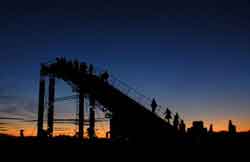
I want to play on the slide but as I’m about to begin the ascent I spot the Dogfish on the move and quickly plot an intercept course. The Dogfish is a roving tiki bar that I had ridden on a couple of days before, and I knew they’d have a lively scene going on. The Department of Mutant Vehicles sets a high standard these days, which means that if you want to drive around on the playa you have to have a car that is also a cool work of art. I’ve seen everything from full-fledged pirate ships built on top of buses to golf carts that look like fire-breathing dragons. Climbing onto a moving art car takes practice, but some helpful souls extend their hands and soon I’m sitting on a bouncing barstool, sipping a margarita and marveling at the carnival fantastic still going off all around me in the predawn glow. I didn’t pay for the margarita. I didn’t even trade for it. Nobody sells T shirts or tacos at Burning Man. It’s a gift economy, built on the principle that when thousands of people get together and start giving things away, everybody ends up getting something. Even advertising for off-playa commerce is considered extremely tacky, to the point that people take pains to cover corporate logos on rented vehicles.
Sound is funny on the playa, and never more so than on a moving art car. We pass through the large-scale sound art area, where several raves and dance clubs are thumping to different rhythms. I can also hear the mingling strains of rock, reggae, and disco–and way off in the distance, someone playing the blues really really well on a tenor saxophone. I thank the Dogfish crew for the drink and hop off at The Temple. A couple of fire spinners are working their magic and I stop to watch. Fire spinning wasn’t born at Burning Man, but it grew up there, and it spawned the blossoming Flow Arts movement. Part sexy performance art and part something like yoga, spinning fire both hones and displays the state of relaxed responsive focus known as flow. Dancing with fire is beautiful and dangerous at the same time, which makes it perfect for the playa. A handsome fellow in watermelon-colored leather pants is spinning poi, which is to say that he’s got a fireball on a chain in each hand and he’s dancing with them, gracefully twirling the flaming orbs in hypnotic patterns that leave spiraling traces on my transfixed retinae. Tomorrow night there will be hundreds of fire spinners performing in the Great Circle as part of the extravagant pyrotechnics display that kicks off the Burning of The Man, but this guy is particularly good and when I sit down to watch he moves close enough that I can feel the heat, closing his eyes and slipping into a beatific trance as whirling peril swirls around his graceful flowing form.
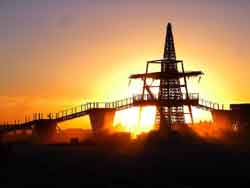
The most moving installation on the playa, The Temple is the size of a large four-story house, with intricate carvings representing dozens of religions and philosophies that filigree almost every available surface in a stunning display of dedication and craftsmanship. There’s also a large Plexiglas tube in its central core with a fire tornado inside, which lights the whole installation from within like a magical lantern. It’s ridiculously ornate, almost defiantly so when you consider that it’s only intended to exist for a few days. Literally thousands of working hours must have gone into its construction, and it’s obvious from just glancing at it that it was a labor of passionate love. Burning Man is a festival of ephemera, and nowhere is the transience more deeply felt than here. The Temple is covered in inscriptions, stretching up as high as a tall person can reach by standing up on someone else’s shoulders. Hundreds of small altars have been erected there by participants, many commemorating the recently deceased. Some represent things that Burners want to let go. Others are inspirational. I find the spot where a picture of my maternal grandmother flutters amongst other people’s ribbons, tickets, trinkets and magical trash; each tiny sacrifice telling a secret story of release and redemption. “Please liberate me from heroin”, one Sharpie-scrawled petition implores. “I’m sorry about my abortion”, another admits. Tears roll down my playa-streaked face as I pour over the prayers of a culture on the edge. A battered teddy bear with the word “forever” emblazoned on its chest shares its penultimate sunrise with me on the second-story balcony. Someone has written a poem there about old friends they just met. Below me, people are preparing for a wedding.
I like the Temple Burn even more than the Burning of The Man. When the Man burns, it’s all fireworks and frenetic energy with most of 50,000 people freaking out with excitement and screaming their heads off like Beatlemania. It’s kind of the big build-up to the blow-out party and the City is ready to pop. There’s so much big fire surrounded by so much potentially mob-like chaos that I sometimes feel poised between a panic attack and an orgasm. When the Temple Burns the mood is reflective: silent and reverent. People cry and hug strangers. Burning Man is pretty much over at that point and it’s time for folks to wrap up their vision quests and start pulling up the rebar. There is a strong sense of having shared something profound amongst the whole supertribe. We’ve survived a week in the desert together. We’ve made new friends and gotten exited about new ideas. We’ve gotten hot and high and tired and frustrated and silly together. We’ve inspired one another to be good art. Some of us have even been reborn.
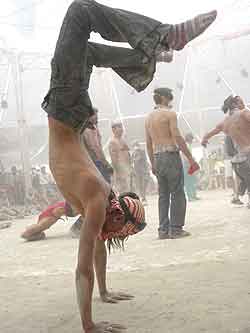
Soon the sun will drive most of us under cover. I decide to walk back to my camp before it gets too hot to fall asleep. A young man in a playafied business suit rides by on a fuzzy bike, playing a blue guitar. His hands are occupied with the instrument and the bicycle seems to be steering itself. “Happy new day!” he calls out to me as he passes. I try to shout my agreement, but he has already disappeared into the haze, like characters do in a poorly rendered computer game. It makes me think about how virtual this all feels. It’s perfect for people who grew up using massively multiplayer online games as a social outlet, because at Burning Man you can present yourself as your avatar. You can be a warrior princess if you want to, or a superhero, and the community will play along and support you recreating yourself. You can be who you’ve always wanted to be, and do what you’ve always dreamed about. Burning Man is not put on by some corporation for our consumption; it’s made by Burners for Burners. It’s alive. It evolves. It’s whatever we make it. It’s a trial answer to the question; “What would people do if they could do anything that they want?” I’m encouraged to report that when most people are given almost total freedom, they tend to create beauty and make people happy.
I remember watching movies about the ’60s when I was a kid and thinking that I’d missed all the good stuff. I was wrong, of course. Yet back then, it seemed to me like there had been one great spasm of explosive freedom before I was born, and then it all slipped back to business as usual. Now ever-increasing change has taken business as usual off the menu, but most people still feel like spectators. Unsure of how to turn the juggernaut of history, many of us bury our heads in the silicon confetti, rendering ourselves too numb even to despair. Burning Man illustrates that we can do anything we put our minds to. Burning Man creates a context in which we feel free and inspired to be the change we want to see in the world. Burning Man makes me feel that this is the most exciting possible time to be alive and the best part is just beginning. Burning Man is the epicenter of a true cultural revolution that turns spectators into participants in the art of life, and there is nothing more dangerous and beautiful than that.
—-
All images from Burning Man 2009 collection, courtesy Seuss dean


